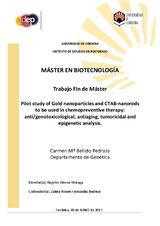Mostrar el registro sencillo del ítem
Pilot study of Gold nanoparticles and CTAB-nanorods to be used in chemopreventive therapy: anti/genotoxicological, antiaging, tumoricidal and epigenetic analysis
| dc.contributor.author | Bellido Pedraza, Carmen Mª | |
| dc.date.accessioned | 2019-05-06T09:20:54Z | |
| dc.date.available | 2019-05-06T09:20:54Z | |
| dc.date.issued | 2019 | |
| dc.identifier.uri | http://hdl.handle.net/10396/18476 | |
| dc.description | Premio extraordinario de Trabajo Fin de Máster curso 2016-2017. Máster en Biotecnología | es_ES |
| dc.description.abstract | Nanoparticles (NPs) are particles with dimensions between molecules and microscopic structures. They have many uses, but one of the most important is in Biomedicine cancer therapies. Due to NPs can be synthesized from different materials (gold, silver, aluminium, etc.), with different shapes (spherical, rods, etc.) and sizes within the nanometric range, it is crucial to know what material, shape and size will serve us in the future to apply them in Biomedicine. In vivo tests are needed, and in this study toxicity, antitoxicity and longevity tests have been carried out using Drosophila melanogaster as a model organism to evaluate their intervention in some degenerative processes. In addition, in vitro cytotoxicity, DNA fragmentation, global methylation and comet assays were performed using the human promyelocytic cell line HL60 to evaluate some biological activities related to chemoprevention. None of the concentrations tested of AuNPs and CTAB-AuNRs reached the LD50 in D. melanogaster. On the other hand, only one concentration of AuNPs (0.05 nM) was statistically different respect to the postitive control in the antitoxicity test; However, all tested concentrations except the highest concentration of CTAB-AuNRs showed significant differences regarding positive control. None of the concentrations of both tested substances were genotoxic. As for the longevity tests, a decrease in the D. melanogaster survival is induced as concentration increased. According to the in vitro tests, none of the substances tested was cytotoxic to promyelocytic HL60 cells as they did not reach IC50. No DNA fragmentation was observed when HL60 cells were treated with AuNPs. In contrast, DNA fragmentation was induced at intermediate concentrations of CTAB-AuNRs. Moreover, genetic damage was observed after the comet assay at certain concentrations of AuNPs (0.100; 0.200 nM) and CTAB-AuNRs (2E-5 and 2E-13 nM). At the epigenomic level, the AuNPs could increase the methylation status of Alu-M1 and LINE-1 repetitive sequences. In contrast, CTAB-AuNRs could decrease the methylation status in Sat-α and increase the methylation status in Alu-M1. Although the results obtained have let some light on the biological activities (safety and chemoprevention), we consider that it is still necessary to deeply carry out tests to determine what type of NPs or NRs are most suitable to be used in Biomedicine. | es_ES |
| dc.description.abstract | Las nanopartículas (NPs) son partículas con dimensiones comprendidas entre las moléculas y las estructuras microscópicas. Poseen multitud de utilidades, pero una de las más importantes es su uso en Biomedicina en terapias contra el cáncer. Debido a que las NPs pueden ser sintetizadas a partir de diferentes materiales (oro, plata, aluminio, etc.), con diferentes formas (esféricas, bastoncillos, etc.) y diferentes tamaños dentro del rango nanométrico, es de vital importancia conocer que material, forma y tamaño nos servirá en el futuro, para aplicarlas en Biomedicina. Ensayos in vivo son necesarios, y en este estudio ensayos de toxicidad, Antitoxicidad y longevidad han sido llevados a cabo usando Drosophila melanogaster como organismo modelo para evaluar su intervención en algunos procesos degenerativos. Además, ensayos in vitro de citotoxicidad, fragmentación del ADN, de metilación global y del cometa fueron realizados usando la línea celular promielocítica humana HL60 para evaluar algunas actividades biológicas relacionadas con la quimioprevención. Ninguna de las concentraciones ensayadas de AuNPs y CTAB-AuNRs alcanzó la DL50 en D. melanogaster. Por otro lado, tan solo una concentración de AuNPs (0.05 nM) fue estadísticamente diferente respecto al control positivo; sin embargo, todas las concentraciones testadas excepto la más alta de CTAB-AUNRs mostraron diferencias significativas respecto al control positivo. Ninguna de las concentraciones de ambas sustancias fue genotóxicas. En cuanto a las pruebas de longevidad, se induce una disminución en la supervivencia de D. melanogaster a medida que aumenta la concentración. De acuerdo con los ensayos in vitro, ninguna de las sustancias ensayadas fue citotóxica para las células promielocíticas HL60 ya que no se alcanzó la CI50. No se observó fragmentación del ADN en las células HL60 cuando fueron tratadas con AuNPs. Por el contrario, concentraciones intermedias de CTAB-AuNRs indujeron fragmentación del ADN. Además, fue observado daño genético cuando llevamos a cabo el ensayo del cometa con determinadas concentraciones de AuNPs (0.100; 0.200 nM) y CTAB-AuNRs (2E-5 and 2E-13 nM). A nivel epigenómico, las AuNPs podrían incrementar el estado de metilación de las secuencias repetitivas Alu-M1 y LINE-1. Por el contrario, CTAB-AuNRs provocan una disminución del estado de metilación en Sat-α y lo incrementan en Alu-M1. Aunque los resultados obtenidos han permitido poner en claro las actividades biológicas (seguridad y quimioprevención), consideramos que todavía es necesario realizar profundamente pruebas para determinar qué tipo de NPs o NRs son las más adecuadas para ser utilizadas en Biomedicina. | es_ES |
| dc.format.mimetype | application/pdf | es_ES |
| dc.language.iso | eng | es_ES |
| dc.publisher | Universidad de Córdoba | es_ES |
| dc.rights | https://creativecommons.org/licenses/by-nc-nd/4.0/ | es_ES |
| dc.subject | D. melanogaster | es_ES |
| dc.subject | HL60 | es_ES |
| dc.subject | AuNPs | es_ES |
| dc.subject | CTAB-AuNRs | es_ES |
| dc.title | Pilot study of Gold nanoparticles and CTAB-nanorods to be used in chemopreventive therapy: anti/genotoxicological, antiaging, tumoricidal and epigenetic analysis | es_ES |
| dc.type | info:eu-repo/semantics/masterThesis | es_ES |
| dc.rights.accessRights | info:eu-repo/semantics/openAccess | es_ES |
| dc.contributor.tutor | Alonso Moraga, Ángeles | |
| dc.contributor.tutor | Fernández Bedmar, Zahira Noemí |

